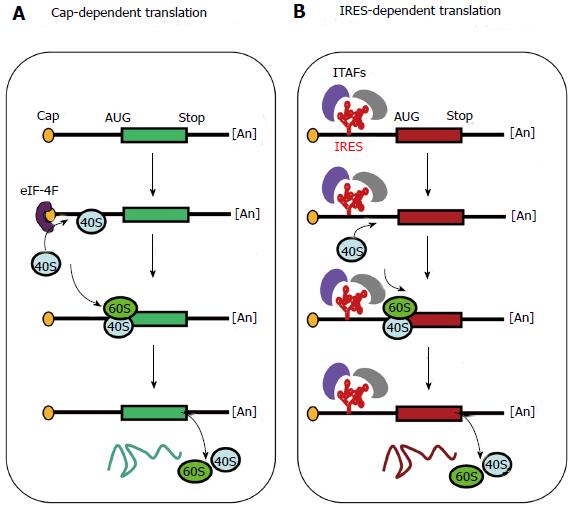Copyright
©The Author(s) 2015.
World J Exp Med. Feb 20, 2015; 5(1): 11-20
Published online Feb 20, 2015. doi: 10.5493/wjem.v5.i1.11
Published online Feb 20, 2015. doi: 10.5493/wjem.v5.i1.11
Figure 1 Cap-dependent and internal ribosome entry site-dependent initiation, two alternative mechanisms of translation.
A: The so-called cap-dependent ribosome scanning mechanism predicts that ribosome 40S subunit binds to the mRNA 5’ end. Ribosome binding requires the initiation factor 4F (eIF-4F, composed of the three proteins eIF-4E, -4A and -4G). Then the mRNA is unwound under the control of the helicases eIF-4A and -4B, allowing the ribosome to scan the mRNA until recognition of an initiation codon (classically AUG)[11,12]; B: When an Internal ribosome entry site (IRES) is present in the mRNA 5’ untranslated region, IRES trans-acting factors (ITAFs) allow ribosome 40S internal recruitment, independently of the presence of cap and eIF-4F. The IRES-dependent mechanism occurs in the case of picornavirus uncapped mRNAs as well as for cellular capped mRNAs.
- Citation: Renaud-Gabardos E, Hantelys F, Morfoisse F, Chaufour X, Garmy-Susini B, Prats AC. Internal ribosome entry site-based vectors for combined gene therapy. World J Exp Med 2015; 5(1): 11-20
- URL: https://www.wjgnet.com/2220-315X/full/v5/i1/11.htm
- DOI: https://dx.doi.org/10.5493/wjem.v5.i1.11









